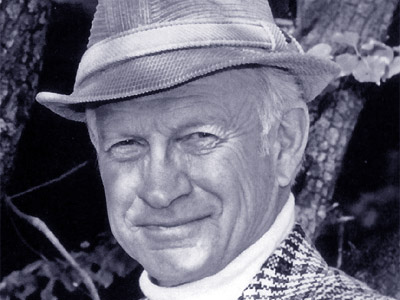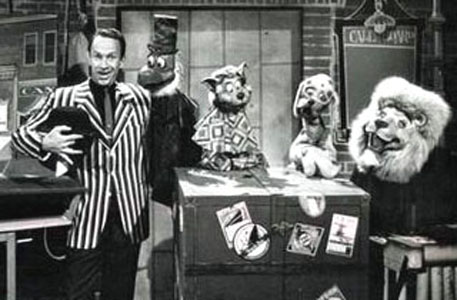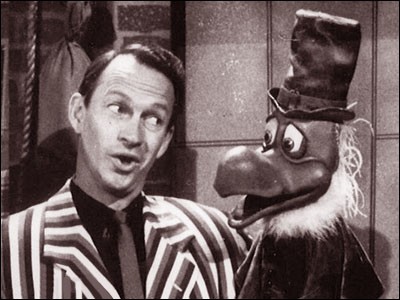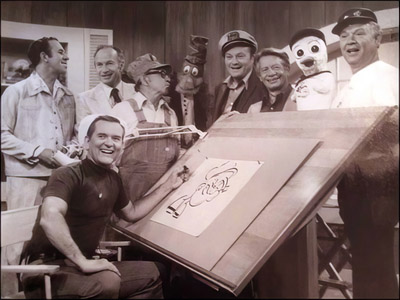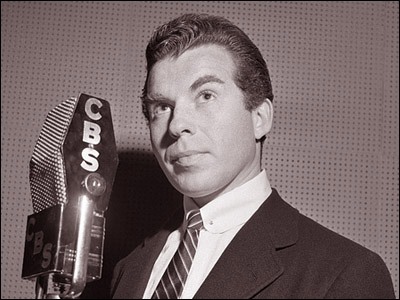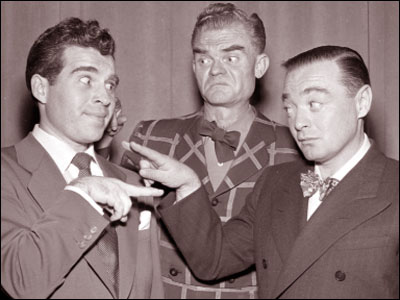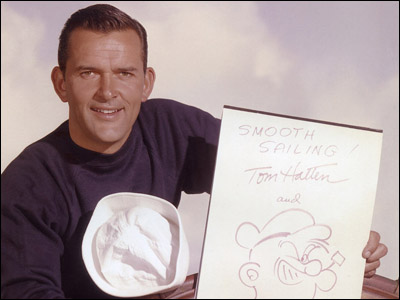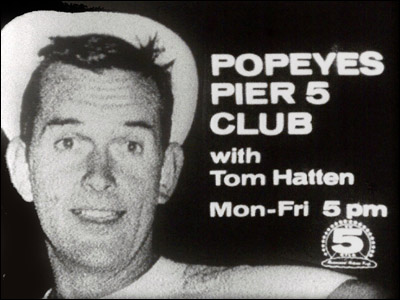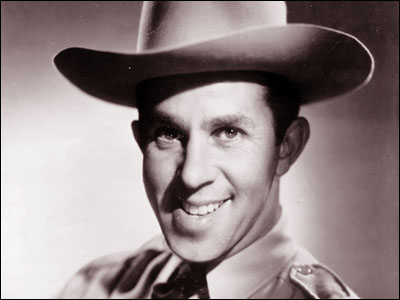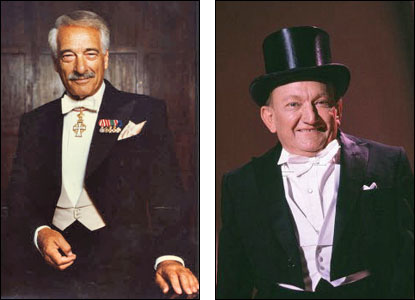
Don Messick
by Mark Evanier
ORIGINALLY PUBLISHED 11/21/97
Comics Buyer's Guide

In the forties, M.G.M. was the movie studio with, they claimed, "more stars than there are in the heavens." No one thought that was excessive bragging; not with a roster of players that included Gene Kelly, Fred Astaire, Judy Garland, Mickey Rooney, the Marx Brothers, Clark Gable, and Tom and Jerry.
Tom and Jerry were the lowest-paid of the batch. That's because they were drawn.
For a decade and a half, the producer-director team of William Hanna and Joseph Barbera conjured up short cartoons of the cat/mouse team. Their films — highly-popular to the point of winning Oscars — ran proudly before M.G.M. movies in theaters until 1956, when M.G.M. decided to get out of animation.
Suddenly unemployed, Bill and Joe knew there was scant future in making cartoons for theatrical release. Instead, they formed an operation to produce them for television. That meant doing them a lot faster and a whole lot cheaper. The last seven-minute Tom and Jerry cartoons had been produced on a budget of $65,000 apiece. The first five-minute Ruff n' Reddy TV films were made for $2700 each.
The cutback was achieved many ways. Ruff was a feisty little cat and Reddy was an easygoing dog, and neither of them moved a lot. That their adventures were fun to watch had a lot to do with the cleverness of the scripts and with two men — Don Messick and Daws Butler. Don did the voice of Ruff, Daws did the voice of Reddy, and they split all the other parts.
Daws and Don were two of the best voice actors ever. Hire one of them and you had an instant cast. Either could play a six-year-old boy, a doddering octogenarian, a feisty Irish policeman, a gravel-voiced stevedore, a hysterical teen-ager in the throes of puberty, a whimpering Russian Tsar, and an inebriated lhasa apso with a bad stutter. And he could play all of them at once, arguing with one another, each voice interrupting the next.
That's what either could do. Put both of them in a studio and you had a rep company of infinite possibilities. And what's more, they were funny.
Ruff n' Reddy was a good start. Then Bill and Joe sold the Kellogg's people on a show called Huckleberry Hound, which featured three separate cartoons. Each week, you got the adventures of Pixie & Dixie (Don was Pixie, Daws was Dixie and their eternal rival, the Brando-like Mr. Jinks). You also got a wonderful cartoon of Yogi Bear (Daws was Yogi, Don was his sidekick Boo Boo, as well as playing the long-suffering Ranger Smith). And there was the title character's cartoon (Daws was Huck, Don was whatever supporting players were needed each time).
If one assessed the animation, one would find this show woefully deficient by the Disney Scale. But 6-year-olds just care if it's funny. I was six when Huckleberry Hound went on the air so I can testify: They were very funny — in large part because of Daws and Don.
Daws, who passed away around nine years ago, was one of the dearest, most talented men I have ever met. Today, the cartoon business abounds with talented folks who studied in his acting classes. Someday soon, I will have to devote a column or three to this wonderful person.
Don Messick, I regret to report, died on October 24, 1997. I'd like to tell you about him now.
Don Messick was born in Buffalo, New York in 1926. They didn't get his mother to the hospital in time and Don was born in an ambulance.
His family soon moved to Maryland where, at the age of 12, Don began hearing strange voices out of nowhere. That was odd enough but soon, people around Don began hearing them, as well. It didn't take long for a doctor to deduce that the voices were coming from Don. He was unconsciously talking to himself and others.
Years later, he recalled the experience: "The doctor said, 'Lots of people talk without saying anything, but you're a freak. You say things without even talking.' He told me to gargle with pink ink. Instead, I got myself a wooden partner and became a ventriloquist." Soon, with a whole repertoire of voices at his command, he broke into local radio, took acting lessons, played night clubs and dabbled in summer stock theater. In 1947, fresh from the Army, he headed for Los Angeles and began to perform on the radio shows of the day.
Making the rounds, he met another new radio actor — Daws Butler, who was himself fresh out of the Navy. They became friends and Daws, who was also starting to do animated cartoons, helped his pal break into that field.
Don could never recall quite what his first voice job was but it was probably a line or two as Droopy. A gent named Bill Thompson originated and usually performed Droopy's voice. Tex Avery, who directed the mush-mouthed mutt's cartoons, was always adding a new gag at the last minute and calling Thompson back to record one more line. Often, Thompson wasn't available so Tex himself would imitate the voice or have Daws (who did other roles in his films) approximate it. Neither was completely satisfactory.
One time, Daws told Tex he knew an actor who could replicate the distinctive voice better than anyone. Messick came in and did the voice so well, he became the Designated Pinch Droopy. Years later when Thompson passed away, Don inherited the role.
He and Daws sometimes did commercials together, but it was when Hanna-Barbera started up that they became the studio "A" team. Don soon proved his value, not only to voice "star" characters but also as a utility infielder.
On the original Jonny Quest series, he played Jonny's father, Dr. Benton Quest. He was one of the Hillbilly Bears, he was Precious Pupp, he was one of The Impossibles, he was Gloop and Gleep on The Herculoids. He was Hong Kong Phooey's cat, the Chan Clan's dog, the Harlem Globetrotters' pooch, and dozens of other non-verbal creatures.
He was Godzooky on the Godzilla series. He was Sebastian the Cat and Bleep the Alien on Josie and the Pussycats. On Shazzan!, he did the voice of a camel.
He was Muttley on the Wacky Races and Dastardly and Muttley in Their Flying Machines and he was Mumbly (big difference) on Mumbly and on Scooby's All-Star Laff-a-Lympics.
He even worked on a lot of non-Hanna-Barbera shows. He was Tadpole on Spunky & Tadpole, and he was Hampton the Pig on Tiny Toon Adventures.
Now, this is a pretty impressive list but for several reasons, it's woefully incomplete. First off, no one ever hired Don Messick to do one voice. So if he did one part on a show, he probably did a half-dozen other characters. Also, as I mentioned, directors often used him as a "wild card," playing all sorts of supporting players, so he was heard on hundreds of shows wherein he did not play a regular character.
And the list is also incomplete because…well, it's incomplete. I haven't even mentioned the several Smurfs he played. Or the Jetsons' dog.
In fact, I haven't even mentioned Scooby Doo.
That's right: For over twenty years, Don made all those weird, expressive sounds — many of them starting with the sound of the letter "R" — that emanated from the longest-running cartoon superstar created for television…Scooby Doo.
Don was amazing. I've worked with all the great cartoon voice artists and no one could match him at multiple roles. (I even directed him a few times, which was mostly a matter of hiring him and then getting out of the way.) He could play nine people in a cartoon, all talking to each other. If you weren't watching, you'd swear nine separate people were making the sounds.
The oft-told story about Don — and it happened many times — had to do with overlapping. That means two actors talking at the same time, which drives the sound editors crazy. And the way the story went was that a director would have to halt a session and tell the actors, "The actor playing Pete and the actor playing Sam keep overlapping."
And there would be a pause before Don Messick said, "I'm playing both those parts."
In late September of '96, Don was in a recording session at Hanna-Barbera when something horrible happened.
Don had done thousands and thousands of recording sessions in his lifetime. He was always on time, always cooperative, always letter-perfect in his performance. If you are a director, you pray for actors like Don Messick. He had never, ever let anyone down.
Suddenly, in this session, he turned pale and muttered, "I can't do this anymore." Then he stumbled out of studio and went home. (No one seems to know exactly how he got home. Don lived about a two-hour drive from Hanna-Barbera.)
Another actor who was there at time told me, "If it had been anyone else, we'd have figured the guy had the flu or he had a hangover or something. But for Don Messick to not finish a job…we all started crying because we knew it had to be something very, very bad."
The next day, Don's agent phoned around town to quietly spread the word that Don Messick was retired, and that other actors should be cast to take over his characters.
That was doubly-chilling. Most actors want their agents to wait until they're dead, buried and well into rigor mortis before they let their roles be recast. It was obvious to everyone in the animation community that the long, glorious career of Don Messick had come to an end.
But some of us felt we'd been robbed. We wanted the chance to say good-bye to Don.
On October 12, 1996, Joe Barbera sent a limo to fetch Mr. and Mrs. Messick. They were chauffeured to Don's favorite Chinese restaurant for a "retirement party."
If you admire cartoon voice actors (and I do), the event was crammed with folks to admire. There was Henry Corden, who has been the second voice of Fred Flintstone, even longer than the late Alan Reed was the first. And there was Jean Vander Pyl, who has been the one and only Wilma Flintstone, all that time. (Messick did the voice of Bamm-Bamm on The Flintstones, along with hundreds of other supporting characters.)
There was Casey Kasem, who is a popular announcer and disc jockey, but whose big cartoon voice credit is all those years as Shaggy on the various Scooby Doo shows. (As mentioned, Don was Scooby Doo and, except for one season, his feisty nephew Scrappy, as well.)
There was Lucille Bliss, who has worked for every studio in the business, but who worked with Don on The Smurfs when she was Smurfette and he was Papa Smurf.
There was Gary Owens, another great announcer and TV personality, who played Space Ghost on the show of the same name. (Don was Space Ghost's monkey mascot Blip, as well as many of the villains.)
There was June Foray, the premier voice actress of the field, the voice of Rocky the Flying Squirrel, Natasha Fatale, and Tweety's owner, Granny, among hundreds of others. She had worked with Don hundreds of times in cartoons and commercials.
There was Howard Morris, the great character actor and director, who did the voice of Mr. Peebles on Magilla Gorilla (Don was Ricochet Rabbit on the same show). Howie also played various characters on The Jetsons (Don was the dog Astro on that show, and he also did various characters, including my favorite, a robot named Uniblab.) Howie was also Atom Ant originally but one day, he suggested that Joe Barbera do something anatomically-impractical, and then Don wound up playing Atom Ant.
There was Teresa Ganzel, who does occasional cartoon voice work, but who is best remembered as Johnny Carson's last Matinee Lady, and as a star of the short-lived situation comedy, The Duck Factory. (Don did a rare on-camera acting job playing a cartoon voice actor on The Duck Factory.)
And there were voice actors who work too much and play too many roles for me to start listing them here: Maurice LaMarche, Neil Ross, Gregg Berger, Walker Edmiston, Sharon Mack, Marvin Kaplan, Greg Burson, and others.
Daws Butler's widow Myrtis was there. So were animation producers like Joe Barbera and Harry Love, directors like Don Jurwich, and writers like Paul Dini and Earl Kress. It was quite an assemblage of folks, all there to pay tribute to Don Messick and to tell him how much we loved him.
Mr. Messick's speech was slurred from what we were told was a stroke. Strangely enough, while he was unable to actually form sentences, he was still able to make the "noise" of Scooby Doo. He was wearing a Scooby tie and he communicated with each of us by pointing to the Great Dane and muttering a little "thank you" in Scooby-speak. It came out as "Rank roo" but it was touching and warm, and I heard someone say, "Don made Scooby talk all those years…and now Scooby is helping Don to express himself."
At the end of the afternoon, a lot of us had damp eyes as we said good-bye to Don. We meant it as "good-bye for now," but I think most of us presumed it was in perpetuity. A few weeks later, those who inquired about visiting Don in his home were told that he was too ill, and that his doctors did not expect him to get better. He passed away quietly a little more than a year later but never worked again.
I found out about nine hours ago and have been writing this and calling friends ever since. Our loss is great…and it's not that we're going to miss the sound of Don Messick's voice. True, it was a part of all our childhoods, but we can turn on the Cartoon Network any hour of the day or night and the odds of hearing Messick are pretty good. (If he's not on the show that's on now, wait. He'll be on the next one…)
No, what a lot of us will miss is Don. He was a true gentleman, a true professional, and he did his job as well as humanly possible. And maybe just a little bit better than that, even.
